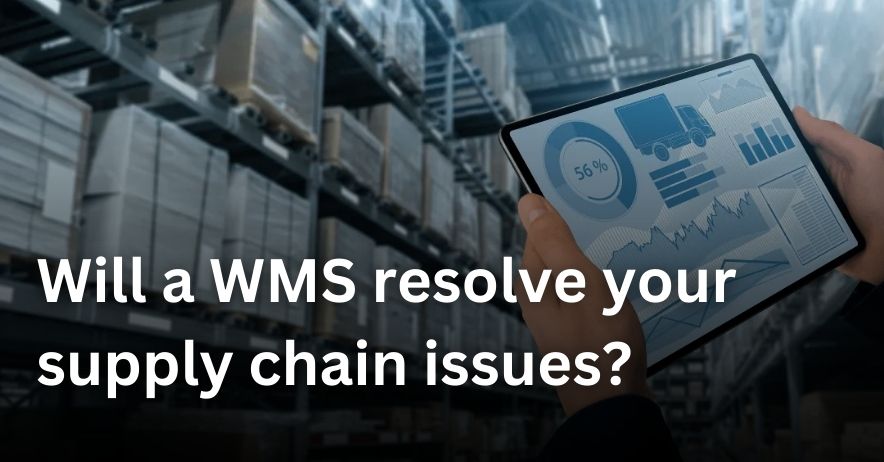Will a WMS resolve your supply chain issues?

Free your new WMS to deliver increased efficiency, accuracy, and inventory control.
Not just mild relief from your current problems.
Senior Management saves the day!
Senior Management isn’t happy.
Expecting a pleasant stroll through your warehouse, they found it an ordeal.
After their string of speeches and a distinct lack of listening, they share their finding. To you it’s a simple statement of fact.
“There’s a mountain of excess inventory and our customer service levels are inadequate. It’s clogging our warehouse and hurting our business”
And their insightful conclusion? “It’s inventory mismanagement...but we’ll fix that.”
You try to explain but get interrupted as they say, “A new WMS will fix this mess!”
In a second attempt to explain you're interrupted again. “No need to thank us. We’re here to solve your problems.“
Someone shakes your hand and adds, “That’s why we’re in Senior Management.”
A panacea for all problems?
Such an offer is great news. A new WMS will deliver increased efficiency, accuracy, and inventory control. Each of these benefits you, your warehouse, and your customers.
But a new WMS won’t fix any underlying problems. It might offer some mild relief, but not if there are serious upstream problems. They need fixing.
Anyone with problems upstream has problems downstream. Problems in planning and procurement show up in inventory. Either too much or too little in the wrong place at the wrong time.
A new WMS can drive significant benefits. But it isn’t the perfect panacea for all those upstream problems.
Help!
This issue came up in a discussion with a group of customers. They could all recount similar situations from their junior careers. Their management teams launched into a new software implementation underprepared. They found themselves needing to correct an endless list of upstream problems. This was on top of existing time and budget pressures. It pushed internal and external team relations to the limit.
Their common view in hindsight was…
- A seasoned WMS Implementation team has seen many supply chains from the inside. Yes, they’re attuned to the issues, their drivers, and their solutions. Yes, within reason they can give some fast, free, and frank advice. But unless you request it, you don’t sign them up to fix all the issues in your supply chain.
- They will set your warehouse up for success. But you need to play your part. You need to give the implementation team and their WMS the oxygen they need to thrive. You need to fix your own problems first – the causes, not the symptoms.
Which team are you on?
In the past I have seen client teams at both extremes. At one end: the calm, well resourced, and organised operation. At the other end: the over-worked, under-resourced, and chaotic. Both had successful outcomes, both followed their own distinct paths.
At one extreme the WMS implementation team has clear air to execute their tasks. The WMS team has open access to all in the client’s team. They can discuss operational issues, understand constraints, agree on solutions, and proceed. Finding time for training is often the challenge. But the efficient implementation gives more time to train the client’s team.
At the other extreme, the WMS implementation is a daily grind of challenges. The client team is a challenge to meet with. They find it difficult to explain their processes. They disagree on the solutions. Time to work on the WMS implementation shrinks. Milestones stretch further apart. The WMS Implementation team must split its time. WMS Implementation stops while supply chain processes are re-built. These aren't only within the warehouse operation, but upstream too.
Implementations are best for clients who know what they’re doing, what they need, and are keen for you to deliver. Give me the over-worked, under-resourced and chaotic lean team any day!
Maximise your ROI.
A good WMS Implementation Team will always be able to highlight a client’s supply chain issues. No WMS will reach its potential return on investment while they remain unfixed. Why put new sails on a boat with a hull covered in barnacles? The best time to fix those problems is before the WMS implementation begins. Improvements made upstream afterwards may conflict with the new WMS. Are those WMS conflicts identifiable and fixable? Yes. Is it ideal and efficient? No.
Spend time to save time.
Successful WMS implementations depend on a foundation of solid supply chain processes. With all due respect to your Senior Management, you know the state of your upstream processes. You know where the ‘rocks’ lie. You know what needs fixing. Fixing known upstream problems today will save time tomorrow. Remember. You want your new WMS to deliver its full capability. Your new WMS can deliver increased efficiency, accuracy, and inventory control. You want more than mild relief from upstream problems.
TAGS
- WMS (51)
- Warehouse Best Practice (46)
- Implementing a WMS (29)
- Managing your warehouse (19)
- Omni Channel (18)
- eCommerce (18)
- Blog (16)
- Supply Chain Best Practice (16)
- Customer Journey (9)
- Mid-Level (8)
- Warehouse optimisation (7)
- General Tips (5)
- Industry General (5)
- Information (5)
- Trends (5)
- managing your Supply Chain (5)
- saudi arabia (5)
- Press Release (4)
- smart warehouse (4)
- 3PL (3)
- News (3)
- ERP (2)
- Entry-level (2)
- ROI (2)
- Case Study (1)
- OMS (1)
- Picking (1)
- Solution-Specific (1)
- Transport Management System (1)
Take A Look At The Results Of A Successful WMS Implementation.
See how Tarsus Distribution, in collaboration with SCJ boost overall efficiency by 60%



